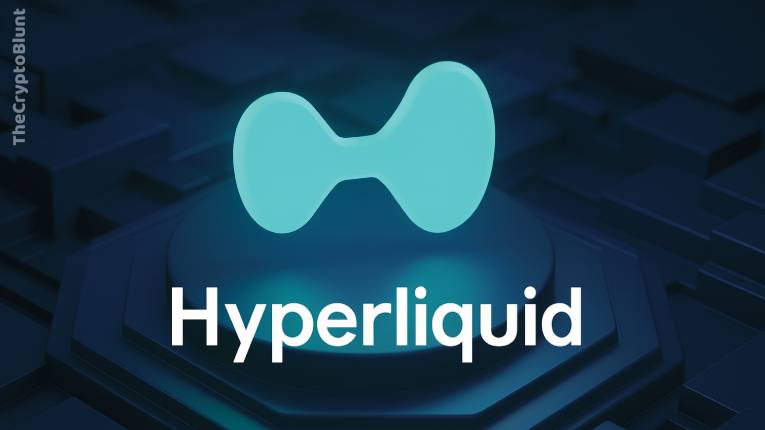When I first dipped my toes into decentralized finance (DeFi), the promise of self-custody and transparency was incredibly appealing. However, I often found myself frustrated by the slow transaction speeds, high “gas fees” (network transaction costs), and clunky user interfaces that made trading feel like a chore, especially when compared to the sleek, rapid experience of centralized exchanges (CEXs) like Binance or Coinbase. Then, I encountered Hyperliquid.
- Laying the Groundwork: Essential Blockchain Concepts
- The Need for Speed: What is Hyperliquid?
- The Minds Behind the Momentum: Hyperliquid’s Founders and Journey
- Dispelling the Myths: Addressing Common Misconceptions About Crypto and Hyperliquid
- Your First Steps into the Hyperliquid Ecosystem: A Beginner’s Guide
- The Road Ahead: The Future of Hyperliquid
Hyperliquid isn’t just another decentralized exchange (DEX); it’s a revolutionary platform designed to bridge the gap between the speed and efficiency of traditional financial trading and the core principles of decentralization. It aims to offer a CEX-like experience – with features like deep liquidity, high leverage, and sub-second transaction finality – all while ensuring users retain full control over their assets, without the need for cumbersome “Know Your Customer” (KYC) processes.
But what exactly is Hyperliquid? Who are the ambitious minds behind this high-performance trading hub? How did it come to be, and what makes it so different from other DEXs? What can you actually do with Hyperliquid, beyond just trading, and what does its future hold as it continues to evolve in the competitive DeFi landscape? This comprehensive guide will delve deep into Hyperliquid, demystifying its core concepts for absolute beginners while offering a unique and detailed perspective on its past, present, and potential future.
Laying the Groundwork: Essential Blockchain Concepts
Before we dive into the specifics of Hyperliquid, let’s briefly define some foundational terms that are crucial to understanding any cryptocurrency and decentralized application. If you’re new to this space, think of these as your basic building blocks.
- Cryptocurrency: In its simplest form, cryptocurrency is digital money secured by cryptography. Unlike traditional money issued by governments or banks, cryptocurrencies operate on decentralized networks, meaning no single entity has control over them. They exist purely as digital entries on a distributed ledger.
- Blockchain: Imagine a continuously growing list of records, called “blocks,” which are linked together using cryptography. Each block contains a timestamp and transaction data, and once a block is added, it cannot be altered, creating an immutable and transparent record. This “chain of blocks” is maintained by a network of computers, not a central server.
- Decentralization: This is the core philosophy of blockchain. It means that power and control are distributed across a network, rather than being concentrated in a single entity (like a bank or government). This makes the system more resilient to censorship, manipulation, and single points of failure.
- Decentralized Exchange (DEX): A DEX is a peer-to-peer marketplace where cryptocurrency transactions occur directly between crypto traders, without the need for a centralized intermediary like a traditional exchange. This means you retain custody of your assets throughout the trading process.
- Perpetual Futures (Perps): These are a type of derivative contract that allows traders to speculate on the future price of an asset without an expiry date. Unlike traditional futures, perpetual contracts don’t expire, meaning traders can hold positions indefinitely, as long as they maintain sufficient margin.
- Layer 1 (L1) Blockchain: This refers to a primary blockchain network (e.g., Bitcoin, Ethereum, Solana). Hyperliquid, notably, operates on its own custom-built Layer 1 blockchain, rather than being a “Layer 2” solution built on top of an existing chain like Ethereum.
- Consensus Mechanism (HyperBFT): How do all the computers in a decentralized network agree on the correct order of transactions and prevent fraud? Through a consensus mechanism. Hyperliquid utilizes HyperBFT, a custom-built, high-performance consensus algorithm optimized for speed and low latency, combining elements of Proof of Stake (PoS) with Byzantine Fault Tolerance (BFT).
The Need for Speed: What is Hyperliquid?
Hyperliquid is a high-performance, decentralized perpetual exchange (DEX) built on its own custom Layer 1 blockchain. Its primary goal is to offer a centralized exchange (CEX)-like trading experience – characterized by speed, deep liquidity, and high leverage – while upholding the fundamental principles of decentralized finance (DeFi): self-custody, transparency, and permissionless access.
What truly sets Hyperliquid apart is its core design. Unlike many DEXs that rely on Automated Market Makers (AMMs) or are built on existing, sometimes congested, L1s or L2s, Hyperliquid developed its own blockchain. This bespoke architecture allows it to optimize specifically for high-frequency trading of perpetual contracts and spot assets.
How Hyperliquid Works: The Engine of Decentralized Trading
Hyperliquid’s architecture is a testament to its focus on speed and efficiency.
- Custom Layer 1 Blockchain (HyperCore & HyperEVM):
- HyperCore: This is the specialized engine optimized for perpetual futures and spot order books. It’s built for extreme speed and efficiency, allowing for sub-second transaction finality (median 0.2 seconds) and the ability to process up to 200,000 orders per second. This is comparable to the performance of top centralized exchanges.
- HyperEVM: Alongside HyperCore, Hyperliquid integrates an Ethereum Virtual Machine (EVM). This means developers can build and deploy smart contracts on Hyperliquid using familiar Ethereum tools and languages (like Solidity), and these dApps can seamlessly interact with Hyperliquid’s high-speed on-chain order books. This bridges Ethereum compatibility with Hyperliquid’s raw performance.
- HyperBFT Consensus Mechanism:
- Optimized for Trading: To achieve its remarkable speed, Hyperliquid developed HyperBFT, a hybrid consensus mechanism. It combines aspects of Proof of Stake (PoS), where validators stake tokens to participate in block production, with Byzantine Fault Tolerance (BFT) for robust security.
- Low Latency & High Throughput: HyperBFT is specifically designed for high throughput and low latency, ensuring that trades, order placements, and liquidations happen in near real-time and are transparently recorded on-chain.
- Validator Network: The network is secured by a set of validators. While initially small (raising some decentralization concerns, which we’ll address later), the team aims to progressively increase decentralization over time.
- Fully On-Chain Central Limit Order Book (CLOB):
- The Difference Maker: Most AMM-based DEXs (like Uniswap) rely on liquidity pools and algorithms for price discovery. Hyperliquid, on the other hand, uses a Central Limit Order Book (CLOB), just like traditional exchanges. This means buy and sell orders are matched directly by the system, providing:
- Deep Liquidity: Orders are filled efficiently, even for large trades.
- Low Slippage: The difference between the expected price and the execution price is minimized.
- Advanced Order Types: Support for market orders, limit orders, stop-loss orders, and even innovative “scale orders” (splitting large orders into smaller ones across a price range).
- Transparency: Because the order book is fully on-chain, every order, trade, and liquidation is transparent and verifiable on the blockchain, eliminating the opaque practices sometimes associated with centralized exchanges.
- The Difference Maker: Most AMM-based DEXs (like Uniswap) rely on liquidity pools and algorithms for price discovery. Hyperliquid, on the other hand, uses a Central Limit Order Book (CLOB), just like traditional exchanges. This means buy and sell orders are matched directly by the system, providing:
- Zero Gas Fees for Trading:
- A significant pain point for many DeFi users is high gas fees. Hyperliquid eliminates gas fees for trading. Instead, it charges small, volume-based maker and taker fees, similar to a CEX, making it cost-effective for frequent traders.
- Perpetual Futures with High Leverage:
- Hyperliquid specializes in perpetual futures, allowing traders to speculate on various cryptocurrencies (BTC, ETH, SOL, AVAX, SUI, etc.) with up to 50x leverage. This enables traders to amplify their potential gains (and losses), mirroring a key feature of CEXs.
- Hyperliquidity Provider (HLP) Vault:
- Community Market-Making: Hyperliquid allows users to deposit USDC into the Hyperliquidity Provider (HLP) vault. This vault democratizes market-making and liquidation strategies, traditionally reserved for institutional traders.
- Profit Sharing: HLP participants provide liquidity for the exchange and earn a portion of the trading fees, sharing in the profit and loss (PnL) generated by the vault’s strategies. This mechanism ensures deep liquidity for traders while offering yield opportunities for liquidity providers.
- HYPE Token:
- The native cryptocurrency of the Hyperliquid blockchain is HYPE. It serves multiple functions:
- Governance: HYPE holders can participate in decentralized governance, influencing decisions related to platform updates and changes.
- Staking Rewards: Users can stake HYPE tokens to help secure the network and earn rewards.
- Fee Payments/Discounts: While trading fees are generally low, holding or using HYPE might offer additional benefits or discounts.
- Economic Incentives: HYPE is used to incentivize long-term engagement and growth of the ecosystem, including future emissions and community rewards.
- The native cryptocurrency of the Hyperliquid blockchain is HYPE. It serves multiple functions:
Hyperliquid’s unique combination of a custom, high-performance L1 blockchain with an on-chain CLOB, zero gas fees for trading, and robust perpetuals functionality, aims to offer a superior decentralized trading experience.
The Minds Behind the Momentum: Hyperliquid’s Founders and Journey
Hyperliquid’s development is driven by a team that blends traditional finance experience with deep blockchain expertise.
The Founders: Jeff Yan and Iliensinc
- Jeff Yan: A key figure and co-founder of Hyperliquid Labs. He brings a strong background in traditional finance, having been a former co-founder of Chameleon Trading, a centralized exchange. This experience likely informed Hyperliquid’s design principles, aiming to replicate the efficiency of CEXs in a decentralized environment.
- Iliensinc: Another co-founder, who was a classmate of Jeff Yan’s at Harvard.
- The Team: Hyperliquid Labs comprises experts from prestigious institutions like Caltech, MIT, Citadel (a renowned quantitative trading firm), and Hudson River Trading (another high-frequency trading firm). This blend of academic rigor and high-frequency trading expertise is evident in Hyperliquid’s performance-driven architecture.
The Genesis and Growth of Hyperliquid:
Hyperliquid launched its mainnet in 2023, quickly gaining traction in the DeFi space. Its journey has been marked by a rapid ascent in trading volume and Total Value Locked (TVL), demonstrating a strong market demand for high-performance decentralized derivatives trading.
- No Venture Capital Backing: A notable aspect of Hyperliquid’s ethos is its reported lack of traditional venture capital (VC) funding. This community-centric model aims to align incentives more closely with users, with a significant portion of the HYPE token allocation (over 70%) dedicated to community rewards and future emissions. This distinguishes it from many crypto projects heavily funded by VCs.
- Early Success & Milestones:
- Rapidly became a leading DEX for perpetual futures trading.
- Achieved significant trading volumes, often rivaling or even surpassing those of some centralized exchanges for specific trading pairs.
- The HLP vault attracted substantial liquidity, indicating strong confidence from market makers and liquidity providers.
- Introduced innovative features like “scale orders” (a popular traditional finance order type) and became one of the first perp DEXs to allow memecoin trading, catering to diverse trader needs.
- Community-Driven Approach: The team emphasizes a community-driven approach, actively engaging with users and incorporating feedback. This is also reflected in the token distribution model, which heavily favors the community.
Hyperliquid’s past highlights its origins in a blend of traditional finance and blockchain innovation, driven by a desire to bring institutional-grade trading performance to the decentralized world, all while fostering a community-centric ecosystem.
Beyond the Hype: The Diverse Uses of Hyperliquid
While Hyperliquid is primarily known for its high-performance perpetual futures trading, its ecosystem extends to various functionalities and use cases that benefit traders, developers, and the broader DeFi community.
- High-Frequency Perpetual Futures Trading:
- This is the core utility. Traders can speculate on the price movements of major cryptocurrencies (like BTC, ETH, SOL, AVAX) and even emerging tokens/memecoins with high leverage (up to 50x).
- CEX-like Experience: The on-chain CLOB, sub-second finality, and zero gas fees for trading deliver a trading experience akin to what users expect from centralized exchanges, but with the added benefits of self-custody and transparency.
- Advanced Order Types: Support for various order types (limit, market, stop-loss, take-profit, scale orders) caters to sophisticated trading strategies.
- Spot Trading (via HIP-1):
- With the introduction of HIP-1 (Hyperliquid Improvement Proposal 1), Hyperliquid also supports native token standard for spot trading. This allows projects to deploy their native tokens with on-chain spot order books on Hyperliquid’s L1.
- This expands Hyperliquid’s utility beyond derivatives, offering a robust platform for direct asset exchange.
- Liquidity Provision and Yield Generation (HLP Vault):
- Users can deposit USDC into the Hyperliquidity Provider (HLP) vault. This allows them to act as decentralized market makers, providing liquidity for the perpetuals market.
- In return, HLP participants earn a share of the trading fees, offering a potentially attractive yield on their stablecoin deposits. This is a significant incentive for users to contribute to the platform’s liquidity, making trading smoother for everyone.
- Decentralized Application (dApp) Development (HyperEVM):
- The integration of HyperEVM (an Ethereum Virtual Machine) is a game-changer. It allows developers to:
- Build EVM-compatible dApps: Create decentralized applications using familiar tools and languages from the Ethereum ecosystem.
- Interact with Core Trading Features: These dApps can seamlessly interact with Hyperliquid’s on-chain spot and perpetual futures order books. This opens up possibilities for:
- Automated Trading Strategies: Building sophisticated trading bots and algorithms that can execute strategies directly on-chain at high speeds.
- SocialFi Applications: Developing social trading platforms where users can view and potentially copy other traders’ positions, all on-chain.
- On-Chain Options Trading: Enabling more complex derivatives beyond just perpetuals.
- Lending and Borrowing Protocols: Creating protocols where users can lend out their assets or borrow against collateral, leveraging Hyperliquid’s liquidity.
- The integration of HyperEVM (an Ethereum Virtual Machine) is a game-changer. It allows developers to:
- Community Governance (HYPE Token):
- Holding and staking HYPE tokens grants users governance rights. This means they can participate in decision-making processes, voting on proposals that influence the platform’s updates, features, and future direction. This fosters a truly decentralized and community-driven ecosystem.
- Capital Efficiency:
- Hyperliquid’s architecture allows for high capital efficiency. Funds deposited into the HLP vault are actively used for market-making, contributing to both liquidity and potential returns for providers.
- Cross-margin capabilities (where margin is shared across multiple positions) further enhance capital efficiency for traders.
- Transparent and Auditable Trading:
- Every order, trade, and liquidation is recorded on the Hyperliquid blockchain, making the entire trading process transparent and auditable. This stands in contrast to centralized exchanges where internal processes can be opaque.
Hyperliquid is carving out a niche as a high-performance, developer-friendly blockchain that caters specifically to the needs of sophisticated traders and DeFi innovators, offering both efficient trading and a robust platform for building next-generation financial applications.
Dispelling the Myths: Addressing Common Misconceptions About Crypto and Hyperliquid
The world of crypto is rife with misconceptions, and innovative projects like Hyperliquid often face specific misunderstandings due to their unique technical architecture or market positioning. Let’s address some common myths.
- “All crypto is just for criminals/money laundering.”
- Reality: This is one of the most pervasive and inaccurate myths. While like any financial system, crypto can be misused, its transparent and traceable nature often makes it less appealing for illicit activities than cash or traditional offshore banking. Blockchains are immutable public ledgers, meaning every transaction is recorded and traceable. Law enforcement agencies increasingly use blockchain analytics tools to track illicit funds.
- Hyperliquid’s Context: While Hyperliquid prides itself on being “no-KYC” (meaning no identity verification for trading), this feature appeals to privacy-conscious individuals and those in regions with limited access to traditional financial services, not just criminals. The on-chain nature of Hyperliquid’s order book means all trading activity is public. However, it’s true that the lack of KYC can make it attractive to bad actors for specific money laundering schemes, as a recent report highlighted Chinese police cracking down on cases involving Hyperliquid. This underscores the ongoing challenge for all open and permissionless systems. Reputable projects like Hyperliquid continually work to mitigate such risks and cooperate with authorities where possible, while balancing the core tenets of decentralization and user privacy.
- “DeFi exchanges are too slow and expensive for real trading.”
- Reality: This was a valid criticism for many early DEXs, especially those on congested networks like Ethereum mainnet. High gas fees and slow transaction confirmations made active trading prohibitive.
- Hyperliquid’s Innovation: Hyperliquid directly tackles this myth. By building its own custom L1 blockchain with the HyperBFT consensus mechanism and an on-chain CLOB, it achieves:
- Sub-second transaction finality: Trades execute almost instantly.
- 200,000 orders per second: Handles massive trading volume.
- Zero gas fees for trading: Eliminates a major cost barrier for frequent traders.
- This performance allows Hyperliquid to offer a trading experience that genuinely rivals centralized exchanges, proving that decentralized trading can indeed be fast and cost-effective.
- “Decentralized exchanges are less secure than centralized ones.”
- Reality: This is a nuanced point. Centralized exchanges are often targets for large-scale hacks because they hold users’ funds in custody (you don’t control your private keys). When an exchange is hacked, users can lose everything.
- Hyperliquid’s Security Model: As a DEX, Hyperliquid is non-custodial. This means you always retain control of your private keys and, therefore, your funds. A hack on Hyperliquid’s protocol would be a smart contract vulnerability, which is a different risk.
- Validator Centralization Concern: A key criticism of Hyperliquid’s security (and decentralization) has been its relatively small validator set (initially 4, expanded to 16). While the team aims to expand this, a smaller validator set theoretically presents a higher risk of collusion or a single point of failure compared to, say, Ethereum’s thousands of validators. However, HyperBFT is designed for robust security within this model.
- Smart Contract Audits: Like any DeFi protocol, Hyperliquid’s smart contracts (especially those on HyperEVM) should undergo rigorous security audits to minimize vulnerabilities. While some audit reports for Hyperliquid have faced scrutiny for their scope or availability, the ongoing development in a public environment lends some transparency.
- Overall: While no system is 100% secure, DEXs shift the security burden to the user (managing private keys), which for many, is a preferred model over entrusting funds to a third party. Hyperliquid aims for a blend of high performance with on-chain transparency and user control, which are core security tenets of DeFi.
- “Hyperliquid is just for whales and pro traders.”
- Reality: While Hyperliquid’s advanced features and high-performance capabilities certainly appeal to professional and high-frequency traders, it is designed for anyone to use.
- Accessibility: Its “no-KYC” policy makes it accessible globally to anyone with a crypto wallet. The user interface is clean and intuitive, aiming for a CEX-like ease of use.
- HLP Vault: The Hyperliquidity Provider (HLP) vault allows even smaller capital holders to participate in market-making strategies and earn yield, democratizing opportunities often exclusive to large institutions.
- Spot Trading: The introduction of spot trading further broadens its appeal beyond just derivatives traders.
- While the 50x leverage might attract experienced traders, its underlying infrastructure is built to serve a wide range of users, from retail traders to sophisticated market makers.
By addressing these common misconceptions, we can appreciate Hyperliquid’s genuine innovations and its unique position in the evolving DeFi landscape.
Your First Steps into the Hyperliquid Ecosystem: A Beginner’s Guide
If Hyperliquid’s blend of speed, decentralization, and advanced trading features piques your interest, getting started is straightforward. Remember, while Hyperliquid aims for a CEX-like experience, it’s still a decentralized platform, meaning you are responsible for your own funds.
- Understanding the Basics (Again!): Hyperliquid uses USDC (a stablecoin pegged to the US Dollar) as primary collateral for trading perpetuals. You’ll need USDC on the Arbitrum network to start.
- Acquiring USDC on Arbitrum:
- Centralized Exchanges (CEXs): The easiest way to get USDC is to buy it on a CEX (like Binance, Coinbase, Kraken, etc.) using your local fiat currency (e.g., INR). Once you have USDC on the CEX, you’ll need to withdraw it to a wallet that supports the Arbitrum network. Crucially, ensure the exchange supports withdrawing USDC directly to Arbitrum.
- Bridging from other chains: If you have USDC on other EVM-compatible chains (like Ethereum mainnet, Polygon, or Optimism), you can use a bridge (e.g., the official Arbitrum bridge or third-party bridges like Synapse, Hop Protocol) to transfer your USDC to the Arbitrum network. Be aware of bridge fees and potential delays.
- Choosing a Wallet for Hyperliquid:
- Hyperliquid supports popular EVM-compatible wallets.
- MetaMask: The most widely used browser extension wallet. It’s easy to set up and manage multiple networks, including Arbitrum.
- WalletConnect, Coinbase Wallet, Rabby: Other compatible options.
- Email Login: Hyperliquid also offers a simplified login experience via email, which might be more comfortable for absolute beginners, but it’s important to understand the security implications (it still ties to an on-chain address, but the private key management might be abstracted). For true self-custody, using a browser extension wallet is recommended.
- Hardware Wallets (Cold Wallets): For the highest level of security, especially for significant amounts of funds, always use a hardware wallet (like Ledger or Trezor) in conjunction with your software wallet (e.g., MetaMask). Your private keys remain offline and secure.
- Connecting and Depositing Funds to Hyperliquid:
- Visit the Hyperliquid Website: Go to the official Hyperliquid trading platform.
- Connect Your Wallet: Click on “Connect Wallet” and choose your preferred wallet (e.g., MetaMask). Ensure your wallet is set to the Arbitrum network.
- Bridge Assets to Hyperliquid L1: Hyperliquid has its own native bridge to transfer your USDC from Arbitrum into your Hyperliquid L1 account (often referred to as your “Hyperliquid wallet”). This step moves your funds from Arbitrum onto Hyperliquid’s custom high-performance blockchain, making them available for gas-free trading.
- Initial Deposit: You’ll need to make an initial deposit of USDC. This will be your margin for trading perpetuals.
- Trading on Hyperliquid:
- Choose a Market: Select the cryptocurrency perpetual pair you want to trade (e.g., BTC/USD, ETH/USD).
- Understand Order Types: Familiarize yourself with market orders (execute immediately at current price), limit orders (set a specific price to buy/sell), stop-loss orders (limit potential losses), and take-profit orders (secure gains).
- Leverage: Understand how leverage works (e.g., 50x leverage means a small price movement can lead to significant gains or losses). Start with low leverage until you’re comfortable.
- “One-Click Trading”: Hyperliquid offers a streamlined trading experience where, once set up, trades can be executed with a single click, without repeated wallet confirmations.
- Participating in the HLP Vault (Optional):
- If you’re interested in providing liquidity and earning yield, you can explore depositing USDC into the HLP vault via the platform’s interface. Understand the risks associated with market-making and impermanent loss.
- Staking HYPE (Optional):
- If you acquire HYPE tokens (the native token, available on some CEXs like KuCoin or directly on Hyperliquid’s spot market), you can stake them on the platform to earn rewards and participate in governance.
A Crucial Word of Caution (Essential Disclaimer): Trading perpetual futures, especially with high leverage, is extremely risky. It can lead to rapid and substantial financial losses, potentially exceeding your initial investment. Cryptocurrency markets are highly volatile and unpredictable. This guide is for educational purposes only and does not constitute financial or investment advice. Always conduct your own thorough research (DYOR) and understand the significant risks involved before engaging in any trading activities. Never invest or trade with money you cannot afford to lose.
The Road Ahead: The Future of Hyperliquid
Hyperliquid’s rapid growth since its launch positions it as a significant player in the decentralized derivatives space. Its future is focused on continued performance enhancement, ecosystem expansion, and community-driven development.
- Continued Performance and Scalability:
- HyperBFT Optimization: Further refinements to the HyperBFT consensus mechanism and the underlying L1 architecture will aim to sustain its high throughput and low latency as user adoption and trading volume increase.
- Scalability Beyond 200,000 TPS: The team is likely to explore ways to push past the current 200,000 orders per second, with theoretical scalability potentially exceeding 1 million orders per second, ensuring it remains competitive with the fastest centralized exchanges.
- HyperEVM Ecosystem Expansion:
- Developer Adoption: A major focus will be attracting more developers to build dApps on HyperEVM, leveraging its high performance and direct interaction with the on-chain order books.
- New DeFi Applications: Expect a growing variety of DeFi applications, including more sophisticated lending/borrowing protocols, options trading, automated trading strategies, and potentially even decentralized social trading platforms built on Hyperliquid. Initiatives like CoreWriter (expected to launch soon) are designed to improve user experience and enable new types of DeFi applications.
- HIP-3: The upcoming HIP-3 is anticipated to bring significant technical benefits and facilitate the creation of “breakthrough applications,” potentially catapulting the ecosystem to new levels of adoption.
- HYPE Token Utility and Governance:
- Enhanced Governance: As the ecosystem matures, the role of the HYPE token in decentralized governance will likely strengthen, giving the community more direct control over protocol upgrades and future development.
- Tokenomics Evolution: While the current distribution heavily favors the community, future tokenomics might introduce new incentives or mechanisms to further align HYPE holders with the long-term success of the platform.
- Increased Liquidity and Market Depth:
- The HLP vault’s continued growth will be crucial for maintaining deep liquidity, which is vital for attracting larger traders and institutional participants.
- Attracting more professional market makers to the platform will further enhance liquidity and reduce slippage.
- Interoperability:
- While Hyperliquid operates on its own L1, seamless interoperability with other major blockchains (especially Ethereum and its Layer 2s, Solana, etc.) will be key for attracting cross-chain liquidity and users. This will likely involve robust bridging solutions.
- User Growth and Market Dominance:
- Hyperliquid aims to reach over 1 million users by the end of 2025, demonstrating its ambition to become a dominant player in the DeFi derivatives market.
- Its ability to offer a CEX-like experience without KYC will continue to be a significant draw for a wide range of traders globally.
- Addressing Decentralization Concerns:
- The team will likely need to address ongoing concerns regarding the centralization of its validator network. Progressively increasing the number of validators and further decentralizing control will be critical for long-term trust and resilience, aligning with the core ethos of DeFi.
Hyperliquid is not just building a decentralized exchange; it’s building a high-performance blockchain infrastructure designed for the future of on-chain finance. Its focus on speed, efficiency, and a CEX-like user experience, combined with the transparency and self-custody of DeFi, positions it for continued innovation and growth in the rapidly evolving crypto landscape.
Conclusion: Hyperliquid – The Future of On-Chain Trading is Fast, Transparent, and Yours
Hyperliquid stands as a powerful testament to the relentless innovation within the decentralized finance space. By constructing its own high-performance Layer 1 blockchain and embracing a fully on-chain central limit order book, it has effectively shattered the misconception that decentralized exchanges must be slow, expensive, or clunky. For traders, it offers an unprecedented blend of speed, leverage, and cost-efficiency, rivaling the best centralized platforms while maintaining the core tenets of self-custody and transparency.
For beginners, Hyperliquid represents a compelling example of how blockchain technology can address real-world pain points, not just in financial transactions but in creating more equitable and accessible financial markets. While trading perpetual futures carries significant risk, the underlying technology demonstrates how DeFi can evolve to meet the demanding needs of professional traders and, in turn, open up new possibilities for everyone.
The journey of Hyperliquid is a dynamic one, constantly pushing the boundaries of what’s possible in decentralized trading. Its commitment to a community-driven model, combined with its ambitious roadmap for ecosystem expansion via HyperEVM, positions it as a key player to watch in the years to come. We encourage you to delve deeper, understand the intricacies, and perhaps, take your first step into a new era of on-chain trading.















